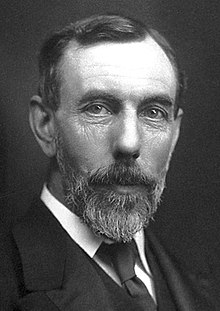Neon
![]()
The title of this article is ambiguous. For other meanings, see Neon (disambiguation).
Neon (Greek νέος néos, German 'neu') is a chemical element with the symbol Ne and atomic number 10.
In the periodic table it is in the 8th main group, or the 18th IUPAC group, and therefore belongs to the noble gases. Like the other noble gases, it is a colourless, extremely inert, monatomic gas. In many properties, such as melting and boiling point or density, it stands between the lighter helium and the heavier argon.
In the universe, neon is one of the most common elements, but on Earth it is relatively rare because, as with helium, a large part of the gas has escaped into space. It is mainly found in the earth's atmosphere, only small amounts are trapped in rocks.
Like krypton and xenon, neon was discovered in 1898 by William Ramsay and Morris William Travers through fractional distillation of liquid air. The best known application is the fluorescent tubes or neon lamps, in which neon is excited to glow in a typical orange-red colour by gas discharges.
History
In 1894, argon was the first noble gas to be discovered by Lord Rayleigh and William Ramsay. In 1895, Ramsay also isolated helium, previously known only from the solar spectrum, from uranium ores. From the laws of the periodic table, he recognized that between helium and argon there must be another element with an atomic mass of about 20 u.
Therefore, from 1896 onwards, he initially investigated various minerals and meteorites and the gases emitted by them when heated or dissolved. Ramsay and his colleague Morris William Travers were not successful, however, helium and rarely argon were found. Also the investigation of hot gases from Cauterets in France and from Iceland brought no results.
Finally, they began to examine 15 litres of crude argon isolated from liquid air and to separate it by liquefaction and fractional distillation. The first element thus separated and detected on the flame spectrum was krypton, and on 13 June 1898 they finally succeeded in isolating a lighter element from the lower-boiling fraction of the crude argon. This Ramsay and Travers named neon, after the Greek νέος néos, German 'new'. A short time later, they were able to obtain another element, xenon, from the fraction containing krypton.
The first application of the newly discovered gas was the neon lamp developed in 1910 by the Frenchman Georges Claude: neon filled into a glass tube is excited to glow by high voltages.

William Ramsay
Nucleosynthesis
Neon, especially the isotope 20Ne, is an important intermediate product in the nucleosynthesis in stars, but is only formed during carbon burning. During helium burning at about 200 - 106 K, 20Ne is not formed due to the small capture cross section of 16O for α-particles, only the isotopes 21Ne and 22Ne can be formed from the heavier 18O. If the temperature and density of a star increase significantly after the helium has been consumed, carbon burning occurs, in which two carbon atoms fuse to form an excited magnesium isotope 24Mg*. This forms 20Ne through α-decay.
With a further increase in temperature and pressure, neon burning occurs, in which 20Ne reacts in α-decay to 16O or fuses with the resulting helium nuclei to form 24Mg.
Due to the higher sensitivity of 20Ne compared to 16O to gamma radiation, this takes place before the reactions of the lighter oxygen nucleus, which are actually to be expected. Only after the end of the neon burning does the oxygen burning take place, in which heavier elements such as silicon, phosphorus and sulphur are formed from 16O.
Search within the encyclopedia


